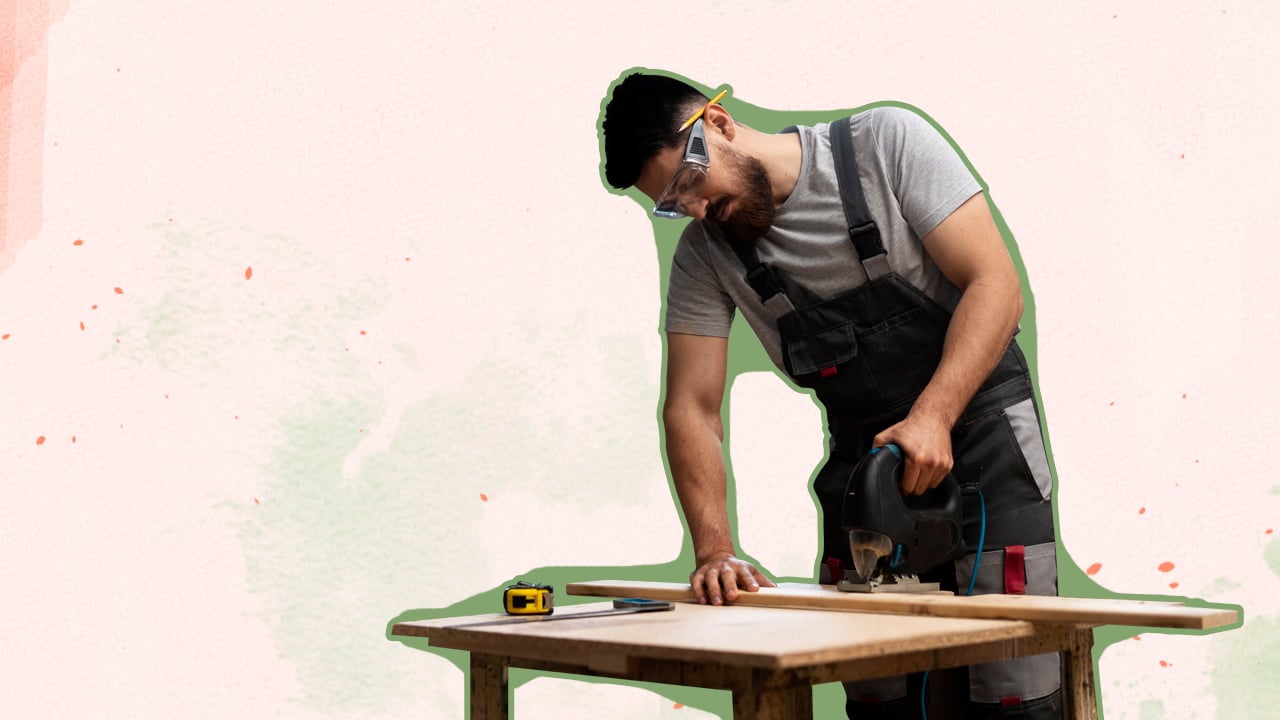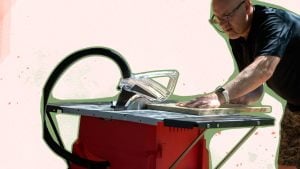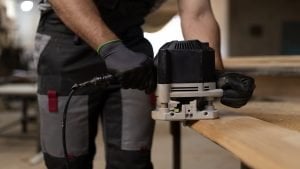Particle board is a versatile material used to make various home furnishings and kitchen cabinets. It can be cut using several tools, such as a jigsaw, circular saw, table saw, utility knife, etc.

I had a couple of particle boards and screws for particle board lying around in my garage, mainly because I didn't know how to use them, let alone cutting the boards correctly.
I realized that many people had the same dilemma as I did. So, with a little bit of research and some help from my DIY enthusiast friends, I have compiled this comprehensive guide on how to cut a particle board. Without further ado, let's dive in!
What Is A Particle Board?

A particle board is a utility material that can often be seen sandwiched between wood or even plastic veneers. It is used for building cabinets, countertops, shelving, and other home furnishings on a budget.
When compared with other engineered wood boards (like plywood, oriented strand board, and medium-density fibreboard) used for interior construction and cabinetry, it is the least expensive option. However, it is also comparatively the most fragile and least dense.
When it comes to cutting particleboard, it can be done just like one would cut any other type of wooden boards, be it natural or engineered. But the procedure and the right blade that is to be used heavily depends on the quality of the cut that the user desires to achieve.
Although the particleboard chipping out can be a slight problem, it will not matter if the work is being done quickly and on a fully functional project, like building concrete forms.
The desired outcome should influence the tools and techniques that are used to build the cabinets or shelves. Here is more information on the most effective ways I managed to cut particle boards.
How To Cut A Particle Board
1. Cutting Particle Board On A Tablesaw
A particle board comes in sheets that are 4 feet wide with varying thicknesses. The thickness can be 8 or 10 feet long, so if you want to rip a particle board sheet on a table saw, you need to provide it with ample support on its outfeed side. In the event that you don't have somebody to catch the particleboard, you can substitute it with a sawhorse that is placed 2 or 3 feet behind the table saw.
I noticed that I had to add a few extra boards to the top to allow it to flush with the table saw. Particleboard is much more flexible than other wooden boards like plywood, oriented strand board, or medium-density fibreboard. So, I had to be careful to keep the end of the board from falling lower than the table saw.
Otherwise, it would end up allowing the middle to flex upwards beyond the reach of the blade, making the cutting process a lot harder.
For a precise clean cut, it is necessary to remember two things: using a table saw blade with at least 80 teeth can help cut particle boards effortlessly, and to always cut the sheet with the good side facing upwards. When I experienced vibrations that caused chipping while cutting the sheet, I installed a zero-clearance throat plate insert on my table saw that allowed me to reduce the vibrations significantly.
These throat plates can be purchased at any home improvement store. However, I preferred to make my own. I did this by cutting a piece of plywood that would fit inside the table saw throat and screwing it in place with the table saw blade kept lowered. Then I turned on the saw, raised the blade, and allowed the blade to cut through the recently installed insert.
When using a Kreg screw for particle board, be very careful while driving it in. If the clutch is set too high, the screw will continue to drive and come out on the other side of the board.
2. Circular Saw Cutting Techniques

When cutting particle boards that are used for forming concrete, choosing a circular saw will be more suitable. It is much smoother to cut with and does not pose much of a dust problem, as particleboards do not create as much dust as medium-density fiberboards.
Start by drawing a line along the area you need to cut and use a circular saw along with a utility blade to cut the particle boards more precisely.
However, when using circular saws, there are chances that the edges of the particleboard sheet may chip. To avoid this problem, use different blades that enable smooth cutting and refine your cutting techniques.
With this cutting method, the entire particle board sheet needs to be supported, preferably on a 2x4-sized surface, where it is laid out on its edge. Typically, I use a blade with 60 teeth or more, though the more teeth, the better. Turn the particle board sheet over so the cut is made from the back of the board.
The problem of the sheet chipping out usually arises from the side that is being cut, so turning the board over can help protect the board's good side. If the cutting line is not satisfactory, use a utility knife to score the cut line on the better side before turning the sheet over and cutting it with the circular saw.
3. Cutting Curves In A Particle Board With A Jigsaw
Since particleboards are not as dense as other wooden boards, it is relatively easy to cut in curves using a jigsaw. However, the quality of the blade being used to cut the board significantly determines the quality of the result.
When I'm in a hurry and the quality of the cut does not matter as much, I use a 6 TPI (teeth per inch) jigsaw blade, which gets the job done easily. But at times when quality is of concern, blades with a higher TPI will ensure a clean, precise cut.
Note
Do not choose a jigsaw blade that has very high TPI, as it may cut too slowly and end up burning the wood in the process.
The maximum I would opt for is a 20 TPI blade and keep the saw foot in contact with the surface at all times to reduce any vibrations. Cutting curves from the back of the particle board sheet neither reduces chipping nor is a practical strategy.
As such, the best way to achieve a clean cut line on the sheet is to apply some masking tape on the sheet, mark the cut line on the tape, and then cut through the masking tape. If a large hole needs to be drilled with a spade bit or a hole saw, laying tape is a foolproof way to ensure a clean outcome.
4. Using A Miter Saw
A miter saw is much more precise than a circular saw or jigsaw. It is used to cut through smaller pieces of particle board sheets and when there is a need for angled cuts. This saw requires a blade with at least 80 teeth count and is carbide tipped.
Miter saws are much smaller in size when compared to their table saw counterparts. And this size factor will allow you to make more different cuts from different angles as you move the saw around easily. Table saws and circular saws, on the other hand, mainly help in making straight cuts.
The most important aspect of a miter saw is using the right blade to cut the particle board. Blades with a good number of teeth and carbide tips usually give the best cuts. And the better the blade quality, the better the end result.
5. Cutting With The Dremel Tool
Dremel tools are ideal for people who need creative freedom when cutting particle boards. They are typically used for smaller jobs such as polishing, sanding or grinding. But certain Dremel tools can be used for carving and engraving on wood. Some examples are the saber saw and moto-saw tools.
However, a Dremel tool is not ideal for cutting a particle board into larger pieces. The most important factors you need to keep in mind when using a Dremel tool to cut a particle board are the tool's speed and the blade type being used for cutting.
For example, the moto-saw tool has a reciprocal action that garners enough speed to cut through thinner sections of a particle board effectively. I use this tool mainly to engrave on the sheet or when I wish to be creative with the particle boards edges.
Additionally, dremel tools give the user the ability to smoothen out any chips or splinters on the edge of the particle board. This chipping or splinters are usually the result of using a circular saw or table saw to cut larger sections, especially when cutting particle boards for furniture.
However, like any power saw or utility knife, a dremel tool cannot cut through a particle board on the first pass, more so when the board is thicker. The first pass should be done with the right amount of pressure to lightly score the topmost layer of the board. A second pass is what will ensure a cleaner cut and smooth finish.
6. Cutting Particle Board With A Hand Saw
A garage that does not have a hand saw is a rare sight. But the main question is, can a hand saw cut through a particle board? Typically, a hand saw is not the first choice when it comes to tools for cutting a particle board. This is because the cuts will generally be quite jagged or splinter excessively, and straight cuts will be out of the question.
Long story short, a hand saw does not possess the required power and speed to cut through the particle board seamlessly. But if the result or the appearance of the particle board is not of concern, a hand saw can be used to cut it effectively. Keep in mind to sharpen the teeth of the handsaw so as to prevent the intensity of the tear-out.
Protective Measures And Equipment
A particle board comprises sawmill shavings, wood chips, and sawdust. These components make the particle board sheet more prone to chipping and splitting when it is being cut. Hence, taking precautions and wearing safety gear before cutting a particle board sheet is important.
The matter that is released from the particle board when it is being cut can be a safety concern. These tiny wood particles can be very harmful and irritating to the eyes and the lungs if inhaled. So, protect yourself by wearing shatter-resistant eye protection when cutting a particle board. Moreover, there are safety glasses that come with side shields which provide a lot more protection when compared to regular safety goggles.
To protect your lungs, consider wearing a tight-fitting ND95 dust mask that helps prevent any wood chips or particles from being inhaled. Make sure the mask fits snugly around the nose and mouth in order to ensure that wood particles do not seep through.
Last but not least, make sure to protect your hands. Since a particle board can chip and splint when cutting, wearing thick, cut-resistant gloves or thick leather gloves can protect the hands from any possible injury.
Depending on the type of method you use to cut the particle board, use the necessary ear protection. Since table saw, circular saw and other types of power saw produce a lot of noise, they can lead to the damage of unprotected ear drums. Wearing earmuffs or snug-fitting earplugs can block some of the noise and give the ears the protection they need.

How To Cut Particle Board Conclusion
A particle board is an extremely versatile material and can be cut in various ways, to make furniture, cabinets etc. However, some particle boards will have the problem of peeling veneers. In such cases, knowing how to repair peeling veneer on particle board cabinets will be helpful.
A simple method to do so is using contact cement on the veneer and particle board, attach the two, and smooth out any air bubble with a hand or J-roller. You can also trim any excess veneer off the edges.
On that note, I will now say goodbye. For other "how to" guides, check out my articles, like ‘how to install an impact sprinkler.’
